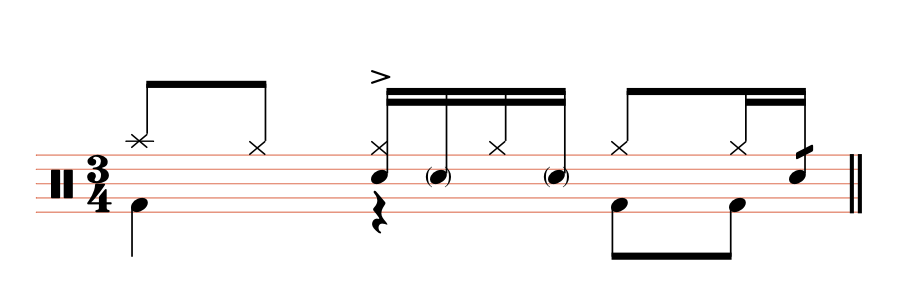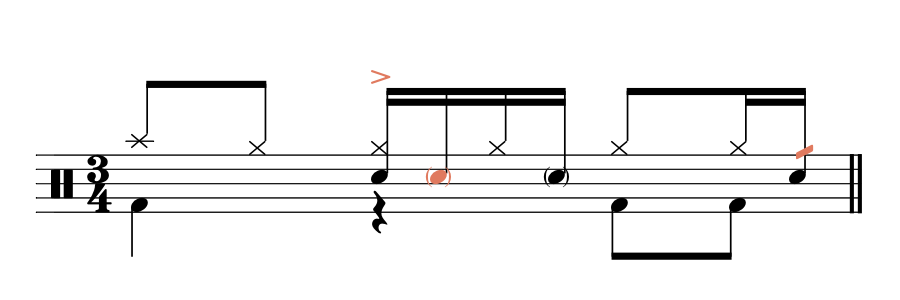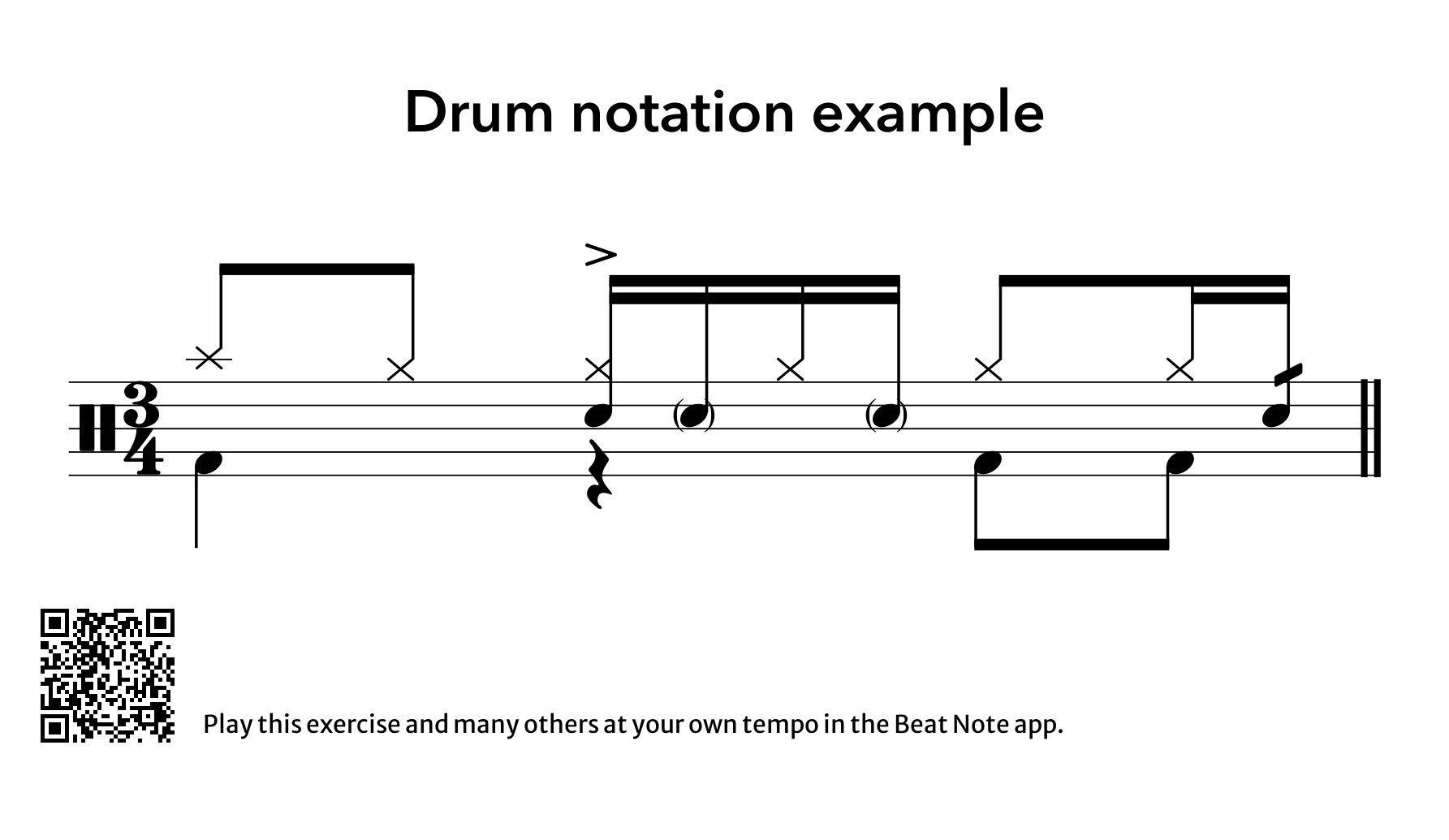Learning to play the drums is a fun journey! But many beginners have a hard time reading drum exercises or song sheets. Fear not! This guide will break down drum notation basics, making it easy and enjoyable. It might seem intimidating, but it’s a breeze once you know how to read drum music. Let’s dive in, shall we?
You’ve probably seen music notation for pianists and guitarists, with staff lines indicating pitch and different note symbols indicating note length. That makes sense for a piano where the pitch changes for every note, but for drums…?
In This Article
How to Read Drum Sheet Music
Drum sheet music is a visual representation of rhythms and patterns played on a drum kit. It combines symbols, notes, and staff lines to convey the unique language of drummers. This language, known as drum notation, tells you which drums to hit, when to hit them, and how hard to play. It’s a way of translating rhythms and beats into symbols that can be read and understood.
Drum notation builds upon traditional music notation, adapting it to the drum kit. It employs staff lines, notes, clefs, and time signatures in a way that makes sense for drummers. To illustrate this, let’s examine an example of a measure in 3/4 time. This will serve as our roadmap to explore the different symbols used in drum notation. You can click the play button below to hear how this measure sounds at a relaxed 40 BPM.
Example Drum Measure in 3/4 Time
Open Example Drum Measure in 3/4 Time in Drum Notation by Beat Note to change the tempo
Is There a Standard for Drum Notation?
Short answer: No. There’s no single, universally accepted standard for drum notation. However, there are common conventions that most drummers and music publishers follow. The same measure can look slightly different depending on who wrote it. The goal is to make it easy to read, not to stick to a rigid format.
Understanding the Lines
The five staff lines and the spaces between them indicate which part of the drum kit to play.

For beginners, the tricky part is remembering where each drum goes. When I started drumming, I couldn’t figure out why the high and mid toms were above the snare, but the floor tom was below. Then it hit me: the floor tom is lower because, well, it’s on the floor. Generally, the placement of notes on the staff lines corresponds to where the drum or cymbal is in the kit.
Drum and Cymbal Placement on Staff Lines

Notice a pattern? All the brass—cymbals, hi-hat, crashes, splashes, ride, and hi-hat foot pedals—are notated with a ╳ and positioned above or below the staff lines. The space between the top and bottom staff lines is reserved for drums (snare, toms, bass drum), notated with a ●.
The Two Bars at the Beginning
Drum notation typically starts with a “Clef”, which is represented by two thick vertical lines. This clef signals that the sheet music is written for drummers and percussionists. They almost look like two little drumsticks, don’t they?

Time Signatures
The time signature at the beginning tells us how many beats are in each measure and which note gets the beat. That’s a mouthful, but it’s crucial for drummers! We need to know if we’re counting typical rock music 1-2-3-4 (4/4 time) or 1-2-3 (3/4 time, like a waltz).
Drum Notes Key
Where’s the snare again? Is that note a Crash or a Hi-Hat? Learning any skill is tricky at first but becomes second nature with practice. Until then, here’s a handy key to help you out:

Note Lengths on Drums
In piano, a note sustains as long as you hold the key. For drums, it’s different. Drum hits are quick unless you’re hitting a cymbal and choking it. A snare drum hit sounds the same whether it’s a sixteenth or half note.
That said, note lengths are still crucial for drummers to see how far apart notes are. We often focus on quarter-note intervals. For this, we drummers are usually looking for a quarter-note interval. Some exceptions exist where we notate and read half and whole notes, but they’re rare for beginner sheet music and exercises.
A quarter note interval can contain four 16th notes, two 8th notes, or one-quarter note:

You could write all notes with little flags, but that’s hard to read, especially when mixing different note values. Generally, notes are connected with a beam into groups of 1/4 note length.
In our example, we have three such groups, making it 3/4 time:

What’s often confusing beginners is that there can be a different amount of beams at the top within the same note interval, like in our example in the last group. The number of beams always corresponds to the number of flags of a note:
- 8th notes: 1 flag on the stem for an individual note = 1 beam across the top
- 16th notes: 2 flags on the stem for an individual note = 2 beams across the top
Thus, that last group has one 8th note and two sixteenth notes.
Why Are Some Drum Notes Upside Down?
Great question! In our example, the bass drum is notated “upside down.” This doesn’t change how you play it. It’s just easier to read. You’ll often see hand and feet patterns notated separately, with hand notes facing “up” and foot notes facing “down.” This isn’t a standard, but depending on the context of the music the author might separate notes played with feet to help readability.
Articulations: More than just symbols
Once you understand the notes, it’s time to look at some of the other ornaments and symbols that frequently appear in drum transcriptions:
What Are the Notes in Brackets?
Ghost Notes are one of the different dynamics you can use when playing drums. Think of them as embellishments to indicate when the drummer should play the instrument more softly. As a beginner, you can skip them without changing the beat much.
What is the greater-than sign above the note?
Accents are another important dynamic that drummers use to emphasize certain notes. They are played more forcefully, making them stand out in the groove. Recognize them by the “greater than” sign above the staff lines.
What about other ornaments?
- Diddle: Two consecutive strokes with the same hand, like two quick snare hits. They are notated with a slash through the note stem.
- Flam: A ghost note quickly followed by the main note, creating a thicker sound. Recognize it by a tiny slashed note before the primary note, connected with a slight arc.
- Half-open Hi-Hat: A hi-hat played partially open, producing a sustained, sizzle sound. It is notated with a circle crossed by a vertical line above the note.
- Open Hi-Hat: A hi-hat played fully open, producing a loud, sustained sound. It is notated with a small circle above the note.
Let’s look at the most important the articulation symbols in one place:

In our example, we have Ghost Notes, an accented snare stroke, and a Diddle in the last note:

Got it? Now what?
With these basics, you should be able to read the vast majority of drum scores, sheet music, and exercises without problems.
Ready to put what you’ve learned into action? Work on some beginner exercises, experimenting with Paradiddles, or tackle a song like Foo Fighter’s Everlong! Both make use of many of the drum notation basics we’ve covered on this page.
Create Your Own Drum Beats
All the beats above are created with Drum Notation by Beat Note. The best way to learn is to put what you’ve read into practice! I highly recommend experimenting with different beats to see and experience what these symbols mean.
Try Drum Notation by Beat Note on your mobile device. Give it a shot and download it:

